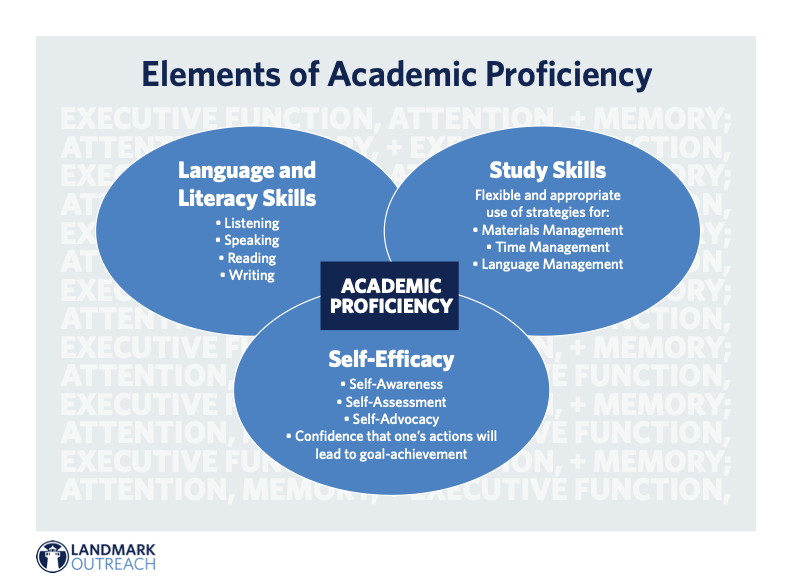Literacy Skills, Study Skills, and Self-Efficacy
When students are successful in school, they are able to manage the academic demands inherent in a classroom. Specifically, this management requires a set of overlapping and interdependent skill sets that include language and literacy skills, study skills, self-efficacy, and intact executive function skills.
The graphic below provides a visual representation of the intersection of these skills.
 Language and literacy skills include listening, speaking, reading, and writing. Study skills include flexible and appropriate use of strategies for managing materials, time and language/information. Self-efficacy (the belief that one’s actions are related to outcomes) includes skills in self-awareness, self-assessments, and self-advocacy. The development of these skills relies on the executive functions, the brains’ super manager.
Language and literacy skills include listening, speaking, reading, and writing. Study skills include flexible and appropriate use of strategies for managing materials, time and language/information. Self-efficacy (the belief that one’s actions are related to outcomes) includes skills in self-awareness, self-assessments, and self-advocacy. The development of these skills relies on the executive functions, the brains’ super manager.
Executive functions empower students to set goals, marshal the various internal and external resources needed to meet them, and make adjustments to ensure their accomplishment. In order to reach the desired goal, whether it is personal or academic, our executive functions help to get us started, manage our emotions or frustrations, engage our working memory, and shift our attention to reach the desired goals. Additionally, we use executive skills to “manage our emotions and monitor our thoughts in order to work more efficiently and effectively” (Dawson & Guare, 2018, p. 3).
This graphic also demonstrates the interconnected nature of the executive functions and language and literacy. Each skill set helps to coordinate and support the other. Our capacity to use productive internal language (e.g. talking to ourselves through challenging or complex tasks) supports the development of executive skills. Inversely, levels of proficiency in listening, speaking, reading, and writing depend upon the executive functions and the mastery of oral and written language facets.
Most students with LBLD develop academic proficiency only when they are taught skills within a supportive environment with curriculum and instructional strategies designed to meet their specific needs. In her book Basic Facts about Dyslexia and Other Reading Problems (2008), Louisa Moats suggests there are six essential components in instruction for students with LBLD. She outlines that effective teaching should be explicit, systematic, cumulative, multisensory, sequential and incremental, and data-driven (2008, p. 58).
References
- Dawson, P., & Guare, R. (2018). Executive skills in children and adolescents: A practical guide to assessment and Intervention. Guilford Press.
- Moats, L. C., & Dakin, K. E. (2008). Basic facts about dyslexia & other reading problems. International Dyslexia Association.



